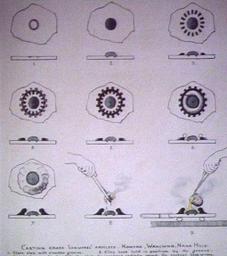sketches by Henry Balfour, 1922 | |
| imgthumb: |

|
| caption: | casting brass 'cogwheel' armlets, Konyak, Wakching village |
| medium: | sketches |
| ethnicgroup: | Konyak |
| location: | Wakching |
| clip: |
 Caption:1. Stone slab with circular groove 2. Clay boss held in position by the groove. 3. Small clay septa fixed to the slab and arranged radially round the central boss or core. |
| clip: |
 Caption:4. Second ring of clay septa outside the first, alternating with these, closing the ends of the radial interspaces. 5. The two sets of clay septa pressed together and smoothed over. The interspace between these and the central core forms the mould for the 'cogwheel' armlet. 6. Clay ring laid upon the ring of septa, leaving a narrow opening all round the clay core. |
| clip: |
 Caption:The clay ring pressed down and united with the clay septa, the whole smoothed over. 8. Coating the inside of the completed mould with pig's fat. The fat is held clipped in a split stick the forked end of which is ignited, the heat melting the fat. |
| clip: |
 Caption:Pouring the molten brass from the crucible into the mould. For this purpose, the stone slab upon which the mould is built up is lifted with wooden tongs and rested upon a ring-pad lying upon a larger slab of stone. When sufficiently cooled the mould is broken up and the brass armlet removed for finishing off. |